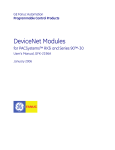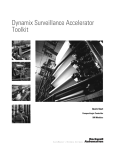Download XM-441 Expansion Relay Module
Transcript
User Guide Firmware Revision 5 XM-441 Expansion Relay Module Catalog Numbers 1440- REX00-04RD Important User Information Solid-state equipment has operational characteristics differing from those of electromechanical equipment. Safety Guidelines for the Application, Installation and Maintenance of Solid State Controls (publication SGI-1.1 available from your local Rockwell Automation sales office or online at http://www.rockwellautomation.com/literature/) describes some important differences between solid-state equipment and hard-wired electromechanical devices. Because of this difference, and also because of the wide variety of uses for solid-state equipment, all persons responsible for applying this equipment must satisfy themselves that each intended application of this equipment is acceptable. In no event will Rockwell Automation, Inc. be responsible or liable for indirect or consequential damages resulting from the use or application of this equipment. The examples and diagrams in this manual are included solely for illustrative purposes. Because of the many variables and requirements associated with any particular installation, Rockwell Automation, Inc. cannot assume responsibility or liability for actual use based on the examples and diagrams. No patent liability is assumed by Rockwell Automation, Inc. with respect to use of information, circuits, equipment, or software described in this manual. Reproduction of the contents of this manual, in whole or in part, without written permission of Rockwell Automation, Inc., is prohibited. Throughout this manual, when necessary, we use notes to make you aware of safety considerations. WARNING: Identifies information about practices or circumstances that can cause an explosion in a hazardous environment, which may lead to personal injury or death, property damage, or economic loss. ATTENTION: Identifies information about practices or circumstances that can lead to personal injury or death, property damage, or economic loss. Attentions help you identify a hazard, avoid a hazard, and recognize the consequence SHOCK HAZARD: Labels may be on or inside the equipment, for example, a drive or motor, to alert people that dangerous voltage may be present. BURN HAZARD: Labels may be on or inside the equipment, for example, a drive or motor, to alert people that surfaces may reach dangerous temperatures. IMPORTANT Identifies information that is critical for successful application and understanding of the product. Allen-Bradley, Rockwell Automation, and XM are trademarks of Rockwell Automation, Inc. Trademarks not belonging to Rockwell Automation are property of their respective companies. 3 Safety Approvals The following information applies when operating this equipment in hazardous locations. Informations sur l’utilisation de cet équipement en environnements dangereux. Products marked "CL I, DIV 2, GP A, B, C, D" are suitable for use in Class I Division 2 Groups A, B, C, D, Hazardous Locations and nonhazardous locations only. Each product is supplied with markings on the rating nameplate indicating the hazardous location temperature code. When combining products within a system, the most adverse temperature code (lowest "T" number) may be used to help determine the overall temperature code of the system. Combinations of equipment in your system arfe subject to investigation by the local Authority Having Jurisdiction at the time of installation. Les produits marqués "CL I, DIV 2, GP A, B, C, D" ne conviennent qu'à une utilisation en environnements de Classe I Division 2 Groupes A, B, C, D dangereux et non dangereux. Chaque produit est livré avec des marquages sur sa plaque d'identification qui indiquent le code de température pour les environnements dangereux. Lorsque plusieurs produits sont combinés dans un système, le code de température le plus défavorable (code de température le plus faible) peut être utilisé pour déterminer le code de température global du système. Les combinaisons d'équipements dans le système sont sujettes à inspection par les autorités locales qualifiées au moment de l'installation. WARNING: RISQUE D’EXPLOSION WARNING: EXPLOSION HAZARD •Do not disconnect equipment unless power has been removed or the area is known to be nonhazardous. •Do not disconnect connections to this equipment unless power has been removed or the area is known to be nonhazardous. Secure any external connections that mate to this equipment by using screws, sliding latches, threaded connectors, or other means provided with this product. •Substitution of components may impair suitability for Class I, Division 2. •If this product contains batteries, they must only be changed in an area known to be nonhazardous. IMPORTANT Model •Couper le courant ou s'assurer que l'environnement est classé non dangereux avant de débrancher l'équipement. •Couper le courant ou s'assurer que l'environnement est classé non dangereux avant de débrancher les connecteurs. Fixer tous les connecteurs externes reliés à cet équipement à l'aide de vis, loquets coulissants, connecteurs filetés ou autres moyens fournis avec ce produit. •La substitution de composants peut rendre cet équipement inadapté à une utilisation en environnement de Classe I, Division 2. •S'assurer que l'environnement est classé non dangereux avant de changer les piles. Wiring to or from this device, which enters or leaves the system enclosure, must utilize wiring methods suitable for Class I, Division 2 Hazardous Locations, as appropriate for the installation in accordance with the product drawings as indicated in the following table. Catalog Number Haz Location Drawings* w/o Barriers XM-120 1440-VST0201RA XM-121 1440-VLF0201RA XM-122 Model Catalog Number w/ Barriers Haz Location Drawings* w/o Barriers w/ Barriers 48238-HAZ 48239-HAZ 48295-HAZ 48299-HAZ XM-320 1440-TPS0201RB XM-360 1440-TPR0600RE 1440-VSE0201RA XM-361 1440-TUN0600RE XM-123 1440-VAD0201RA XM-361 1440-TTC0600RE XM-160 1440-VDRS0600RH XM-440 1440-RMA0004RC 48240-HAZ N/A XM-161 1440-VDRS0606RH XM-441 1440-REX0004RD 48241-HAZ N/A XM-162 1440-VDRP0600RH XM-442 1440-REX0304RG 48642-HAZ N/A XM-220 1440-SPD0201RB 48178-HAZ 51263-HAZ 48640-HAZ 48179-HAZ 51264-HAZ 48641-HAZ * Drawings are available on the included CD Rockwell Automation Publication GMSI10-UM019C-EN-P - June 2010 4 Rockwell Automation Publication GMSI10-UM019C-EN-P - June 2011 Table of Contents Chapter 1 Introducing the XM-441 Expansion Relay Module . . . . . . . . . . . . . . . . 7 XM-441 Module Components. . . . . . . . . . . . . . . . . . . . . . . . . . . . . . . . . 8 Using this Manual. . . . . . . . . . . . . . . . . . . . . . . . . . . . . . . . . . . . . . . . . . . 8 Organization. . . . . . . . . . . . . . . . . . . . . . . . . . . . . . . . . . . . . . . . . . . . 9 Document Conventions . . . . . . . . . . . . . . . . . . . . . . . . . . . . . . . . . . 9 Introduction Chapter 2 Installing the XM-441 Expansion Relay Module XM Installation Requirements. . . . . . . . . . . . . . . . . . . . . . . . . . . . . . . . 12 Wiring Requirements . . . . . . . . . . . . . . . . . . . . . . . . . . . . . . . . . . . . 12 Power Requirements . . . . . . . . . . . . . . . . . . . . . . . . . . . . . . . . . . . . 12 Grounding Requirements . . . . . . . . . . . . . . . . . . . . . . . . . . . . . . . . 13 Mounting the Terminal Base Unit. . . . . . . . . . . . . . . . . . . . . . . . . . . . . 16 DIN Rail Mounting . . . . . . . . . . . . . . . . . . . . . . . . . . . . . . . . . . . . . 17 Panel/Wall Mounting . . . . . . . . . . . . . . . . . . . . . . . . . . . . . . . . . . . 18 Connecting Wiring for Your Module . . . . . . . . . . . . . . . . . . . . . . . . . . 19 Terminal Block Assignments. . . . . . . . . . . . . . . . . . . . . . . . . . . . . . 20 Power Supply . . . . . . . . . . . . . . . . . . . . . . . . . . . . . . . . . . . . . . . . . . 22 Connecting the Relays . . . . . . . . . . . . . . . . . . . . . . . . . . . . . . . . . . . 22 Mounting the Module . . . . . . . . . . . . . . . . . . . . . . . . . . . . . . . . . . . . . . 25 Module Indicators . . . . . . . . . . . . . . . . . . . . . . . . . . . . . . . . . . . . . . . . . 26 Appendix A Specifications . . . . . . . . . . . . . . . . . . . . . . . . . . . . . . . . . . . . . . . . . . . . . . . . . . . . . . . . . 29 Glossary . . . . . . . . . . . . . . . . . . . . . . . . . . . . . . . . . . . . . . . . . . . . . . . . . . . . . . . . . 31 Index . . . . . . . . . . . . . . . . . . . . . . . . . . . . . . . . . . . . . . . . . . . . . . . . . . . . . . . . . 35 5Rockwell Automation Publication GMSI10-UM019C-EN-P - June 2011 6 Table of Contents Rockwell Automation Publication GMSI10-UM019C-EN-P - June 2011 Chapter 1 Introduction This chapter provides an overview of the XM-441 Expansion Relay module. It also discusses the components of the module. For information about Introducing the XM-441 Expansion Relay Module See page Introducing the XM-441 Expansion Relay Module 7 XM-441 Module Components 8 Using this Manual 8 The XM-441 Expansion Relay module provides an additional four relays to any XM measurement module or to the XM-440 Master Relay module. It is a member of the Allen-Bradley™ XM® Series, a family of DIN rail mounted condition monitoring and protection modules that operate both in stand-alone applications or integrate with Programmable Logic Controllers (PLCs) and control system networks. The XM-441 offers four high power relays suitable for use in almost any protection application. Up to two Relay Expansion modules may be connected to the XM-440 Master Relay module, providing an additional four or eight relays. The XM-441 is not an intelligent XM module. It must be connected to either an XM measurement module or the XM-440 Master Relay module in order to function. In addition, it does not consume a node address on the DeviceNet bus. The XM-441 simply extends the circuitry of its host module. No direct configuration of the XM-441 is required. Setup of the XM-441 relays is through its host XM measurement or XM-440 Master Relay module. 7Rockwell Automation Publication GMSI10-UM019C-EN-P - June 2011 8 Introduction XM-441 Module Components The XM-441 consists of a terminal base unit and an instrument module. The XM-441 Expansion Relay Module and the XM-943 Expansion Relay Terminal Base are shown below. Figure 1.1 XM-441 Module Components EXPANSION RELAY XM-943 Expansion Relay Module Terminal Base Unit Cat. No. 1440-TB-D 1440-REX00-04R D XM-441 Expansion Relay Module Cat. No. 1440-REX00-04RD • XM-943 Expansion Relay Terminal Base Unit - A DIN rail mounted base unit that provides terminations for all field wiring required by the XM-441. • XM-441 Expansion Relay Module - Mounts on the XM-943 terminal base unit via a keyswitch and a 96-connector. The XM-441 contains four on-board relays to expand relay capabilities to the XM module to which it is connected. IMPORTANT Using this Manual The host XM module controls the operation of the relays in the Expansion Relay module. Refer to the manual for the specific module for configuration information. This manual introduces you to the XM-441 Relay Expansion module. It is intended for anyone who installs or uses the XM-441 Relay Expansion module. Rockwell Automation Publication GMSI10-UM019C-EN-P - June 2011 Introduction 9 Organization To help you navigate through this manual, it is organized in chapters based on these tasks and topics. Chapter 1 “Introduction” contains an overview of this manual and the XM-441 module Chapter 2 “Installing the XM-441 Expansion Relay Module” describes how to install, wire, and use the XM-441 module. Appendix A “Specifications” lists the technical specifications for the XM-441 module. For definitions of terms used in this Guide, see the Glossary at the end of the Guide. Document Conventions There are several document conventions used in this manual, including the following: The XM-441 Expansion Relay module is referred to as XM-441, Expansion Relay module, device, or module throughout this manual. TIP EXAMPLE A tip indicates additional information which may be helpful. This convention presents an example. Rockwell Automation Publication GMSI10-UM019C-EN-P - June 2011 10 Introduction Rockwell Automation Publication GMSI10-UM019C-EN-P - June 2011 Chapter 2 Installing the XM-441 Expansion Relay Module This chapter discusses how to install and wire the XM-441 Expansion Relay module. It also describes the module indicators and the basic operations of the module. For information about See page XM Installation Requirements 12 Mounting the Terminal Base Unit 16 Connecting Wiring for Your Module 19 Mounting the Module 25 Module Indicators 26 ATTENTION Environment and Enclosure This equipment is intended for use in a Pollution Degree 2 Industrial environment, in overvoltage Category II applications (as defined in IED publication 60664–1), at altitudes up to 2000 meters without derating. This equipment is supplied as “open type” equipment. It must be mounted within an enclosure that is suitably designed for those specific environmental conditions that will be present, and appropriately designed to prevent personal injury resulting from accessibility to live parts. The interior of the enclosure must be accessible only by the use of a tool. Subsequent sections of this publication may contain additional information regarding specific enclosure type ratings that are required to comply with certain product safety certifications. See NEMA Standards publication 250 and IEC publication 60529, as applicable, for explanations of the degrees of protection provided by different types of enclosures. 11Rockwell Automation Publication GMSI10-UM019C-EN-P - June 2011 12 Installing the XM-441 Expansion Relay Module XM Installation Requirements This section describes wire, power and grounding requirements for an XM system. Wiring Requirements Use solid or stranded wire. All wiring should meet the following requirements: • 14 to 22 AWG copper conductors without pretreatment; 8 AWG required for grounding the DIN rail for electromagnetic interference (emi) purposes • Recommended strip length 8 millimeters (0.31 inches) • Minimum insulation rating of 300V • Soldering the conductor is forbidden • Wire ferrules can be used with stranded conductors; copper ferrules recommended ATTENTION See the XM Documentation and Configuration Utility CD for Hazardous Locations installation drawings. The XM Documentation and Configuration Utility CD is packaged with the XM modules. Power Requirements Before installing your module, calculate the power requirements of all modules interconnected via their side connectors. The total current draw through the side connector cannot exceed 3A. Refer to the specifications for the specific modules for power requirements. ATTENTION A separate power connection is necessary if the total current draw of the interconnecting modules is greater than 3A. Rockwell Automation Publication GMSI10-UM019C-EN-P - June 2011 Installing the XM-441 Expansion Relay Module IMPORTANT 13 Power connections are not made directly to the XM-441 module. Rather power is passed via the side connector from the Expansion Module's host module. Refer to that module's User Manual for further details on power requirements. Grounding Requirements Use these grounding requirements to ensure safe electrical operating circumstances, and to help avoid potential emi and ground noise that can cause unfavorable operating conditions for your XM system. DIN Rail Grounding The XM modules make a chassis ground connection through the DIN rail. The DIN rail must be connected to a ground bus or grounding electrode conductor using 8 AWG or 1 inch copper braid. See Figure 2.1. Use zinc-plated, yellow-chromated steel DIN rail (Allen-Bradley part no. 199-DR1 or 199-DR4) or equivalent to assure proper grounding. Using other DIN rail materials (e.g. aluminum, plastic, etc.), which can corrode, oxidize, or are poor conductors can result in improper or intermittent platform grounding. Rockwell Automation Publication GMSI10-UM019C-EN-P - June 2011 14 Installing the XM-441 Expansion Relay Module Figure 2.1 XM System DIN Rail Grounding 1 1440-VST02-01RA DYNAMIC MEASUREMENT 1440-REX00-04RD EXPANSION RELAY 1440-VST02-01RA DYNAMIC MEASUREMENT 1440-REX00-04RD EXPANSION RELAY Power Supply 1440-RMA00-04RC MASTER RELAY 1 1440-REX00-04RD EXPANSION RELAY 1440-VST02-01RA DYNAMIC MEASUREMENT 1440-TSP02-01RB POSITION 1440-REX00-04RD EXPANSION RELAY 1440-REX00-04RD EXPANSION RELAY 1440-VST02-01RA DYNAMIC MEASUREMENT 1440-REX00-04RD EXPANSION RELAY Power Supply 1 Use 14 AWG wire. The grounding wire can be connected to the DIN rail using a DIN Rail Grounding Block (Figure 2.2). Rockwell Automation Publication GMSI10-UM019C-EN-P - June 2011 Installing the XM-441 Expansion Relay Module 15 Figure 2.2 DIN Rail Grounding Block Panel/Wall Mount Grounding The XM modules can also be mounted to a conductive mounting plate that is grounded. See Figure 2.4. Use the grounding screw hole provided on the terminal base to connect the mounting plate the Chassis terminals. Figure 2.3 Grounding Screw on XM Terminal Base Rockwell Automation Publication GMSI10-UM019C-EN-P - June 2011 16 Installing the XM-441 Expansion Relay Module Figure 2.4 Panel/Wall Mount Grounding 1 Power Supply 1 Power Supply 1 Mounting the Terminal Base Unit Use 14 AWG wire. The XM family includes several different terminal base units to serve all of the XM modules. The XM-943 terminal base, Cat. No. 1440-TB-D, is the only terminal base unit used with the XM-441. Rockwell Automation Publication GMSI10-UM019C-EN-P - June 2011 Installing the XM-441 Expansion Relay Module 17 The terminal base can be DIN rail or wall/panel mounted. Refer to the specific method of mounting below. ATTENTION The XM modules make a chassis ground connection through the DIN rail. Use zinc plated, yellow chromated steel DIN rail to assure proper grounding. Using other DIN rail materials (e.g. aluminum, plastic, etc.), which can corrode, oxidize or are poor conductors can result in improper or intermittent platform grounding. You can also mount the terminal base to a grounded mounting plate. Refer to Panel/Wall Mount Grounding on page 15. DIN Rail Mounting Use the following steps to mount the XM-943 terminal base unit on a DIN rail (A-B pt no. 199-DR1 or 199-DR4). IMPORTANT The XM-943 terminal base unit is mounted to the right of the XM module to which it is providing additional relays. 1. Position the terminal base on the 35 x 7.5mm DIN rail (A). Position terminal base at a slight angle and hook over the top of the DIN rail. 2. Make certain the side connector (B) if fully retracted into the base unit. Rockwell Automation Publication GMSI10-UM019C-EN-P - June 2011 18 Installing the XM-441 Expansion Relay Module 3. Slide the terminal base unit over tight against the neighboring terminal base. Make sure the hook on the terminal base slides under the edge of the adjacent base and the side connector is fully retracted. 4. Rotate the terminal base onto the DIN rail with the top of the rail hooked under the lip on the rear of the terminal base. 5. Press down on the terminal base unit to lock the terminal base on the DIN rail. If the terminal base does not lock into place, use a screwdriver or similar device to open the locking tab, press down on the terminal base until flush with the DIN rail and release the locking tab to lock the base in place. 6. Gently push the side connector into the side of the neighboring terminal base to complete the backplane connection. 7. Repeat the above steps to install another Expansion Relay terminal base unit. Up to two Expansion Relay modules can be added to each XM-440 Master Relay module. Panel/Wall Mounting Installation on a wall or panel consists of: • laying out the drilling points on the wall or panel • drilling the pilot holes for the mounting screws • installing the terminal base units and securing them to the wall or panel Use the following steps to install the XM-943 terminal base on a wall or panel. Rockwell Automation Publication GMSI10-UM019C-EN-P - June 2011 Installing the XM-441 Expansion Relay Module 19 1. Lay out the required points on the wall/panel as shown in the drilling dimension drawing below. Side Connector 2. Drill the necessary holes for the #6 self-tapping mounting screws. 3. Retract the side connector into the base unit. Make sure it is fully retracted. 4. Position the terminal base unit up tight against the neighboring terminal base. Make sure the hook on the terminal base slides under the edge of the terminal base unit. 5. Gently push the side connector into the side of the neighboring terminal base to complete the backplane connection. 6. Secure the terminal base to the wall with two #6 self-tapping screws. 7. Repeat the above steps to install another Expansion Relay terminal base unit. Up to two Expansion Relay modules can be added to each XM-440 Master Relay module. Connecting Wiring for Your Module Wiring to the module is made through the terminal base unit on which the module mounts. The XM-441 is compatible only with the XM-943 terminal base unit, Cat. No. 1440-TB-D. Rockwell Automation Publication GMSI10-UM019C-EN-P - June 2011 20 Installing the XM-441 Expansion Relay Module Figure 2.5 XM-942 Terminal Base Unit XM-943, Cat. No. 1440-TB-D Terminal Block Assignments The terminal block assignments and descriptions for the XM-441 module are shown below. ATTENTION WARNING The terminal block assignments are different for different XM modules. The following table applies only to the XM-441. Refer to the installation instructions for the specific XM module for its terminal assignments. EXPLOSION HAZARD Do not disconnect equipment unless power has been removed or the area is known to be nonhazardous. Do not disconnect connections to this equipment unless power has been removed or the area is known to be nonhazardous. Secure any external connections that mate to this equipment by using screws, sliding latches, threaded connectors, or other means provided with this product. Terminal Assignments No. Name Description 0 No Connection 1 No Connection 2 No Connection 3 Reserved 4 Relay 1 N.O. 2 Relay #1 Normally Open contact 2 5 Relay 1 N.O. 1 Relay #1 Normally Open contact 1 6 Relay 2 N.O. 2 Relay # 2 Normally Open contact 2 7 No Connection Rockwell Automation Publication GMSI10-UM019C-EN-P - June 2011 Installing the XM-441 Expansion Relay Module 21 Terminal Assignments No. Name Description 8 Relay 2 N.O. 1 Relay # 2 Normally Open contact 1 9 Relay 3 N.O. 2 Relay #3 Normally Open contact 2 10 No Connection 11 Relay 3 N.O. 1 Relay #3 Normally Open contact 1 12 Relay 4 N.O. 2 Relay #4 Normally Open contact 2 13 Relay 4 N.O. 1 Relay #4 Normally Open contact 1 14 No Connection 15 Chassis 16 No Connection 17 No Connection 18 No Connection 19 No Connection 20 Relay 1 Common 2 Relay #1 Common contact 2 21 Relay 1 Common 1 Relay #1 Common contact 1 22 Relay 2 Common 2 Relay #2 Common contact 2 23 No Connection 24 Relay 2 Common 1 Relay #2 Common contact 1 25 Relay 3 Common 2 Relay #3 Common contact 2 26 No Connection 27 Relay 3 Common 1 Relay #3 Common contact 1 28 Relay 4 Common 2 Relay #4 Common contact 2 29 Relay 4 Common 1 Relay #4 Common contact 1 30 No Connection 31 Chassis Connection to DIN rail ground spring or panel mounting hole Connection to DIN rail ground spring or panel mounting hole DeviceNet bus power input, positive side (red wire) 32 DNet V (+) 33 CAN_High1 34 No Connection 35 No Connection 36 No Connection 37 No Connection 38 Relay 1 N.C. 2 Relay #1 Normally Closed contact 2 39 Relay 1 N.C. 1 Relay #1 Normally Closed contact 1 40 Relay 2 N.C. 2 Relay #2 Normally Closed contact 2 41 No Connection 42 Relay 2 N.C. 1 1 DeviceNet bus connection, high differential (white wire) Relay #2 Normally Closed contact 1 Rockwell Automation Publication GMSI10-UM019C-EN-P - June 2011 22 Installing the XM-441 Expansion Relay Module Terminal Assignments No. Name Description 43 Relay 3 N.C. 2 Relay #3 Normally Closed contact 2 44 No Connection 45 Relay 3 N.C. 1 Relay #3 Normally Closed contact 1 46 Relay 4 N.C. 2 Relay #4 Normally Closed contact 2 47 Relay 4 N.C. 1 Relay #4 Normally Closed contact 1 48 No Connection 49 Chassis Connection to DIN rail ground spring or panel mounting hole 50 DNet V (-)1 DeviceNet bus power input, negative side (black wire) 51 CAN_Low1 DeviceNet bus connection, low differential (blue wire) 1 DeviceNet communication is not used by the XM-943 but DeviceNet connections are available on the terminal base unit and the side connector. Power Supply The host XM module provides power, via the side connector, for the XM-441 module. Connecting the Relays The XM-441 has both Normally Open (NO) and Normally Closed (NC) relay contacts. Normally Open relay contacts close when the control output is energized. Normally Closed relay contacts open when the control output is energized. The alarms associated with the relay and whether the relay is normally de-energized (non-failsafe) or normally energized (failsafe) depends on the configuration of the module. Refer to the User Guide for the specific module for a description of the Relay parameters. Rockwell Automation Publication GMSI10-UM019C-EN-P - June 2011 Installing the XM-441 Expansion Relay Module 23 There are four double pole double throw relays in the XM-441. All relay contacts (24 total) are available for wiring at the terminal base unit, as shown in Table 2.1 on the page 23. All XM relays are double pole. This means that each relay has two contacts in which each contact operates independently but identically. The following information and illustrations show wiring solutions for both contacts; although, in many applications it may be necessary to wire only one contact. IMPORTANT The NC/NO terminal descriptions (pages 20–22) correspond to a de-energized (unpowered) relay. IMPORTANT When the relay is configured for non-failsafe operation, the relay is normally de-energized. When the relay is configured for failsafe operation, the relay is normally energized, and the behavior of the NC and NO terminals is inverted. Table 2.1 Relay Connections for XM-441 Configured for Failsafe Operation Relay 1 Terminals Relay 2 Terminals Relay 3 Terminals Relay 4 Terminals Nonalarm Alarm Wire Contacts Contact 1 Contact 2 Contact 1 Contact 2 Contact 1 Contact 2 Contact 1 Contact 2 Closed Opened COM 21 20 24 22 27 25 29 28 NO 5 4 8 6 11 9 13 12 COM 21 20 24 22 27 25 29 28 NC 39 38 42 40 45 43 47 46 Opened Closed Configured for Non-failsafe Operation Relay 1 Terminals Relay 2 Terminals Relay 3 Terminals Relay 4 Terminals Nonalarm Alarm Wire Contacts Contact 1 Contact 2 Contact 1 Contact 2 Contact 1 Contact 2 Contact 1 Contact 2 Closed Opened COM 21 20 24 22 27 25 29 28 NC 39 38 42 40 45 43 47 46 COM 21 20 24 22 27 25 29 28 NO 5 4 8 6 11 9 13 12 Opened Closed Figures 2.6 and 2.7 illustrate the behavior of the NC and NO terminals when the relay is wired for failsafe, alarm or nonalarm condition or non-failsafe, alarm or nonalarm condition. Rockwell Automation Publication GMSI10-UM019C-EN-P - June 2011 24 Installing the XM-441 Expansion Relay Module Figure 2.6 Relay Connection - Failsafe, Nonalarm Condition Non-failsafe, Alarm Condition Figure 2.7 Relay Connection - Failsafe Alarm Condition Non-failsafe, Nonalarm Condition Alternate Relay Wiring Figures 2.8 and 2.9 show how to wire both ends of a single external indicator to the XM terminal base for failsafe, nonalarm or alarm condition or non-failsafe, nonalarm or alarm condition. Figure 2.8 Relay Connection - Failsafe, Nonalarm Condition Non-failsafe, Alarm Condition Rockwell Automation Publication GMSI10-UM019C-EN-P - June 2011 Installing the XM-441 Expansion Relay Module 25 Figure 2.9 Relay Connection - Failsafe, Alarm Condition Non-failsafe, Alarm Condition Mounting the Module The XM-441 mounts on the XM-943 terminal base unit, Cat. No. 1440-TB-D. You should mount the module after you have connected the wiring on the terminal base unit. ATTENTION The XM-441 is compatible only with the XM-943 terminal base unit. The keyswitch on the terminal base unit should be at position 3 for the XM-441. Do not attempt to install XM-441 modules on other terminal base units. Do not change the position of the keyswitch after wiring the terminal base. ATTENTION WARNING This module is designed so you can remove and insert it under power. However, when you remove or insert the module with power applied, I/O attached to the module can change states due to its input/output signal changing conditions. Take special care when using this feature. When you insert or remove the module while power is on, an electrical can occur. This could cause an explosion in hazardous location installations. Be sure that power is removed or the area is nonhazardous before proceeding. Rockwell Automation Publication GMSI10-UM019C-EN-P - June 2011 26 Installing the XM-441 Expansion Relay Module 1. Make certain the keyswitch (A) on the terminal base unit (C) is at position 3 as required for the XM-441. 2. Make certain the side connector (B) is pushed all the way to the left. You cannot install the module unless the connector is fully extended. 3. Make sure that the pins on the bottom of the module are straight so they will align properly with the connector in the terminal base unit. 4. Position the module (D) with its alignment bar (E) aligned with the groove (F) on the terminal base. 5. Press firmly and evenly to seat the module in the terminal base unit. The module is seated when the latching mechanism (G) is locked into the module. 6. Repeat the above steps to install the next XM-441 module in its terminal base. Module Indicators The XM-441 has a power status indicator (PWR) that is on when power is applied to the module and an activation status indicator for each relay (four in all). The indicators are located on top of the module. Rockwell Automation Publication GMSI10-UM019C-EN-P - June 2011 Installing the XM-441 Expansion Relay Module Figure 2.10 LED Indicators 1440-REX00-04RD EXPANSION RELAY Module Indicators The following tables describe the states of the LED status indicators. Power Status Indicator Color State Description No color Off No power applied to the module. Green Solid Power applied to the module. Relay Indicators (4 in all) Color State Description Red Off On-board relay is not activated. Solid On-board relay is activated. Rockwell Automation Publication GMSI10-UM019C-EN-P - June 2011 27 28 Installing the XM-441 Expansion Relay Module Rockwell Automation Publication GMSI10-UM019C-EN-P - June 2011 Appendix A Specifications The Appendix lists the technical specifications for the XM-441 module. XM-441 Technical Specifications Product Feature Specification Communications Communication interface is via the side connector between the XM-441 and the XM module mounted directly to the left of the XM-441. Side Connector All XM measurement and relay modules include side connectors that allow interconnecting adjacent modules, thereby simplifying the external wiring requirements. The interconnect provides primary power, DeviceNet communication, and the circuits necessary to support expansion modules, such as the XM-441 Expansion Relay module. NOTE: DeviceNet protocol, which is not used by the XM-441, and primary power are passed through the module’s terminal base to modules connected on either side of the XM-441. Indicators 5 LEDs Module Power -green Relay 1 - red Relay 2 - red Relay 3 - red Relay 4 - red Relays Number Four relays, two sets of contacts each DPDT (2 Form C) Contacts 250V AC, 50/60 Hz, 3 A Resistive Failsafe Normally energized (failsafe), or Normally de-energized (non-failsafe) These features are managed/controlled by the host XM module. Refer to the applicable XM module’s specification for details on these features: Latching Time Delay Voting Logic Reset Activation Rockwell Automation Publication GMSI10-UM019C-EN-P - June 2011 30 Specifications XM-441 Technical Specifications Product Feature Specification Power Module 24V DC Consumption 120mA maximum Heat Production 2.9 Watts (9.9 BTU/hr) maximum Environmental Operating Temperature -20 to +65°C (-4 to +149°F) Storage Temperature -40 to +85°C (-40 to +185°F) Relative Humidity 95% non-condensing All printed circuit boards are conformally coated in accordance with IPC-A-610C, Physical Dimensions Height: 3.8in (97mm) Width: 3.7in (94mm) Depth: 3.7in (94mm) Terminal Screw Torque 7 pound-inches (0.6Nm) Approvals (when product or packaging is marked) UL UL Listed for Ordinary Locations UL UL Listed for Class I, Division 2 Group A, B, C, and D Hazardous Locations CSA CSA Certified Process Control Equipment CSA CSA Certified Process Control Equipment for Class I, Division 2 Group A, B, C, and D Hazardous Locations EEX* European Union 94/9/EEC ATEX Directive, compliant with EN 50021; Potentially Explosive Atmospheres, Protection “n” CE* European Union 89/336/EEC EMC Directive C-Tick* Australian Radiocommunications Act, compliant with: AS/NZS 2064, Industrial Emissions * See the Product Certification link at www.rockwellautomation.com for Declarations of Conformity, Certificates and other certification details. Rockwell Automation Publication GMSI10-UM019C-EN-P - June 2011 Glossary alarm An alarm alerts you to a change in a measurement. For example, an alarm can notify you when the measured vibration level for a machine exceeds a pre-defined value. Automatic Device Replacement (ADR) A means for replacing a malfunctioning device with a new unit, and having the device configuration data set automatically. The ADR scanner uploads and stores a device’s configuration. Upon replacing a malfunctioning device with a new unit (MAC ID 63), the ADR scanner automatically downloads the configuration data and sets the MAC ID (node address). baud rate The baud rate is the speed at which data is transferred on the DeviceNet network. The available data rates depend on the type of cable and total cable length used on the network: Maximum Cable Length Cable 125K 250K 500K Thick Trunk Line 500m (1,640ft.) 250m (820ft.) 100m (328ft.) Thin Trunk Line 100m (328ft.) 100m (328ft.) 100m (328ft.) Maximum Drop Length 6m (20ft.) 6m (20ft.) 6m (20ft.) Cumulative Drop Length 156m (512ft.) 78m (256ft.) 39m (128ft.) The XM measurement modules’ baud rate is automatically set by the bus master. You must set the XM-440 Relay module baud rate. You set the XM-440 Relay Master to 125kb, 250kb, 500kb, or Autobaud if another device on the network has set the baud rate. bus off A bus off condition occurs when an abnormal rate of errors is detected on the Control Area Network (CAN) bus in a device. The bus-off device cannot receive or transmit messages on the network. This condition is often caused by corruption of the network data signals due to noise or baud rate mismatch. Change of State (COS) DeviceNet communications method in which the XM module sends data based on detection of any changed value within the input data (alarm or relay status). 31Rockwell Automation Publication GMSI10-UM019C-EN-P - June 2011 32 Glossary current configuration The current configuration is the most recently loaded set of configuration parameters in the XM module’s memory. When power is cycled, the current configuration is loaded with either the saved configuration (in EEPROM) or the factory defaults (if there is no saved configuration). In addition, the current configuration contains any configuration changes that have been downloaded to the module since power was applied. DeviceNet network A DeviceNet network uses a producer/consumer Controller Area Network (CAN) to connect devices (for example, XM modules). A DeviceNet network can support a maximum of 64 devices. Each device is assigned a unique node address (MAC ID) and transmits data on the network at the same baud rate. A cable is used to connect devices on the network. It contains both the signal and power wires. General information about DeviceNet and the DeviceNet specification are maintained by the Open DeviceNet Vendor’s Association (ODVA). ODVA is online at http://www.odva.org. EEPROM See NVS (Non-Volatile Storage). Electronic Data Sheet (EDS) Files EDS files are simple text files that are used by network configuration tools such as RSNetWorx for DeviceNet to describe products so that you can easily commission them on a network. EDS files describe a product device type, revision, and configurable parameters. Help window A window that contains help topics that describe the operation of a program. These topics may include: • • • • An explanation of a command. A description of the controls in a dialog box or property page. Instructions for a task. Definition of a term. MAC ID See node address. Rockwell Automation Publication GMSI10-UM019C-EN-P - June 2011 Glossary 33 master device A device which controls one or more slave devices. The XM-440 Master Relay module is a master device. node address A DeviceNet network can have as many as 64 devices connected to it. Each device on the network must have a unique node address between 0 and 63. Node address 63 is the default used by uncommissioned devices. Node address is sometimes called “MAC ID.” NVS (Non-Volatile Storage) NVS is the permanent memory of an XM module. Modules store parameters and other information in NVS so that they are not lost when the module loses power (unless Auto Save is disabled). NVS is sometimes called “EEPROM.” online help Online help allows you to get help for your program on the computer screen by pressing F1. The help that appears in the Help window is context sensitive, which means that the help is related to what you are currently doing in the program. Polled DeviceNet communications method in which the module sends data in response to a poll request from a master device. slave device A device that receives and responds to messages from a Master device but does not initiate communication. Slave devices include the XM measurement modules, such as the XM-120 Dynamic Measurement module and the XM-320 Position module. virtual relay A virtual relay is a non-physical relay. It has the same capabilities (monitor alarms, activation delay, change status) as a physical relay only without any physical or electrical output. The virtual relay provides additional relay status inputs to a controller, PLC, and an XM440 Master Relay module (firmware revision 5.0 and later). XM configuration XM configuration is a collection of user-defined parameters for XM modules. Rockwell Automation Publication GMSI10-UM019C-EN-P - June 2011 34 Glossary XM Serial Configuration Utility Software XM Serial Configuration Utility software is a tool for monitoring and configuring XM modules. It can be run on computers running Windows 2000 service pack 2, Windows NT service pack 6, or Windows XP operating systems. Rockwell Automation Publication GMSI10-UM019C-EN-P - June 2011 Index C P components terminal base XM-943 8 XM-441 Expansion Relay module 8 connecting wiring 19 relays 22 terminal base XM-943 19 D description terminal base XM-943 8 XM-441 module 8 DIN Rail Grounding Block 14 DIN rail grounding requirements 13 document conventions 9 panel/wall mount grounding requirements 15 power requirements 12 Power Status indicator 27 R relay contacts normally closed 22 normally open 22 relay indicators 27 relays, wiring 22 S specifications 29 T G terminal base mounting on panel/wall 18 terminal base, mounting on DIN rail 16 terminal block assignment 20 grounding requirements 13 DIN rail 13 panel/wall mount 15 I W indicators 26 Power Status 27 Relay 27 installation requirements grounding 13 power 12 wiring 12 introduction 7 wiring to terminal base 19 wiring connections relays 22 wiring requirements 12 X K keyswitch 25 M mounting terminal base unit 16 terminal base unit on panel/walll 18 XM-441 module 25 N normally closed relay contacts 22 normally open relay contacts 22 XM-441 Expansion Relay Module components 8 description 8 grounding requirements 13 indicators 26 introduction 7 mounting 25 power requirements 12 specifications 29 wiring requirements 12 XM-943 terminal base description 8 mounting 16 wiring 19 Rockwell Automation Publication GMSI10-UM019C-EN-P - June 2011 36 Index Rockwell Automation Publication GMSI10-UM019C-EN-P - June 2011 Rockwell Automation Support Rockwell Automation provides technical information on the Web to assist you in using its products. At http://www.rockwellautomation.com/support/, you can find technical manuals, a knowledge base of FAQs, technical and application notes, sample code and links to software service packs, and a MySupport feature that you can customize to make the best use of these tools. For an additional level of technical phone support for installation, configuration, and troubleshooting, we offer TechConnect support programs. For more information, contact your local distributor or Rockwell Automation representative, or visit http://www.rockwellautomation.com/support/. Installation Assistance If you experience a problem within the first 24 hours of installation, review the information that is contained in this manual. You can contact Customer Support for initial help in getting your product up and running. United States or Canada 1.440.646.3434 Outside United States or Canada Use the Worldwide Locator at http://www.rockwellautomation.com/support/americas/phone_en.html, or contact your local Rockwell Automation representative. New Product Satisfaction Return Rockwell Automation tests all of its products to ensure that they are fully operational when shipped from the manufacturing facility. However, if your product is not functioning and needs to be returned, follow these procedures. United States Contact your distributor. You must provide a Customer Support case number (call the phone number above to obtain one) to your distributor to complete the return process. Outside United States Please contact your local Rockwell Automation representative for the return procedure. Documentation Feedback Your comments will help us serve your documentation needs better. If you have any suggestions on how to improve this document, complete this form, publication RA-DU002, available at http://www.rockwellautomation.com/literature/. Rockwell Otomasyon Ticaret A.Ş., Kar Plaza İş Merkezi E Blok Kat:6 34752 İçerenköy, İstanbul, Tel: +90 (216) 5698400 Rockwell Automation Publication GMSI10-UM019C-EN-P - June 2011 38 Supersedes Publication GMSI10-UM019B-EN-P - May 2010 Copyright © 2011 Rockwell Automation, Inc. All rights reserved. Printed in the U.S.A.






































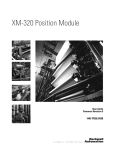
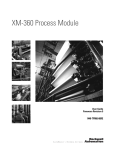

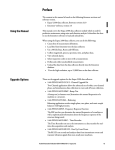
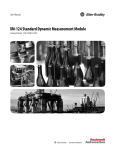
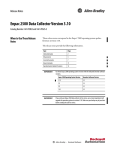
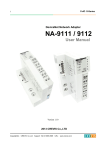

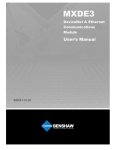
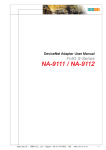
![[incr tsdb()]](http://vs1.manualzilla.com/store/data/005780303_1-7064634619abc733efac654e2a82e90d-150x150.png)
